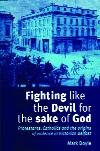Fighting like the devil for the sake of God
Published in 18th-19th Century Social Perspectives, 18th–19th - Century History, Book Reviews, General, Issue 5 (Sept/Oct 2011), Reviews, Volume 19
Fighting like the devil for the sake of God
Mark Doyle
(Manchester University Press, €20)
ISBN 9780719079535
Fighting like the devil for the sake of God is an arresting title for a book that purports to examine the origins of violence in Northern Ireland by pinpointing the moment in time and the unique set of circumstances in the nineteenth century that have fathered the core violence experienced in the recent Troubles. When the Troubles erupted in the late 1960s, Belfast historians Andrew Boyd (Holy war in Belfast) and A.T.Q. Stewart (The narrow ground) sought to put the conflict in context, suggesting that a pattern of violence in Victorian times was merely being re-enacted in the 1960s and 1970s. For many people then, north and south, it was quite a revelation to learn of previous riots. The author, however, eschews the link between past and present violence as too simplistic, as it creates the presumption and expectation that nineteenth-century violence was in some way a necessary precursor that led to the recent Troubles. He has a point. Arguably more important influences on the Troubles were indeed the emergence of new, far-reaching world developments like the civil rights movement in the 1960s, Marxist ideologies, de-industrialisation and significant developments in urban guerrilla warfare, non-existent in Victorian Belfast.Mark Doyle’s book points towards a new paradigm shift whereby violence in northern society can be understood through an analysis of the nature of violence itself. He argues cogently that the origin of violence in Belfast was ‘part of a constructed tradition that arose from a specific historical moment’ when a unique tradition of working-class violence became ingrained in both Protestant and Catholic communities. He identifies the hub of this ‘historical moment’ as emerging in the Belfast riots of 1857 and 1864, and significantly points out that this violence pre-dated any political struggle between nationalists and unionists. To develop his thesis, Doyle draws on the notion of ‘communal deterrence’ to explain how communities in a divided society, fearing violence from the other side, gravitate towards their own side’s violent extremists for protection, thus creating a milieu where violence then becomes ‘endemic and endless with no way out’. Doyle observes that the riots in Belfast in 1857 marked a new development. As people in their droves migrated to the city in mid-century in search of work, rural faction-fighting (vividly portrayed by the nineteenth-century novelist William Carleton) found new expression in an urban setting. In these riots houses were wrecked and inhabitants were left homeless. The riots of 1864 gave a new focus, as rioters now massed about city landmarks like Thompson’s Bank, Brown Street School and the Boyne Bridge. Vigilante groups like the navvies and ship carpenters began to emerge as potent forces reflecting the concerns and fears of local communities. These years were pivotal in establishing a modern pattern of violence in Ulster’s past but the reasons why have gone largely unexamined.The author draws on the methodologies of George Rudé (The crowd in history) and Iver Bernstein (who analysed the 1863 New York riots) and concludes that the violence in Belfast happened because minorities in both communities dominated and intimidated ‘moderates’ and expelled outsiders in order to create a ‘pure’ neighbourhood and workplace. In these moments of crisis class differences within Protestant and Catholic communities collapsed, allowing working-class violence in both communities to go uncensored. By way of contrast, Doyle argues that this scale of Belfast sectarian violence never happened in Victorian Glasgow, which had a similar religious make-up, because Glasgow Protestants were never ‘an embittered settler minority in a frontier society’ and Glasgow Catholics had no history of violent dispossession. Furthermore, in the Scottish city there was no dissension between local and central government as in Belfast.Doyle rejects violence in northern society as a residual problem of a past colonialism and challenges the notion that the eruption of violence in the late twentieth century was inevitable. It was not just a re-run of centuries of trouble that was ‘timeless, indelible, and seemingly ineradicably . . . all bloody variations on the same bleak theme’. That was the Churchillian view. While the map of Europe, and Ireland, was totally reconfigured in the early 1920s, the ‘dreary steeples of Fermanagh and Tyrone’ emerged yet again to spoil the party. Doyle’s contribution is timely. Despite the fact that a new peace map has been drawn up for northern society and become enshrined in a recent settlement, many believe that the elephant in the room, embedded sectarianism, has not gone away. Sectarianism is still the great colossus ever-present in northern society, acknowledged by all but imperfectly understood, leaving people at a loss as to how to address it adequately. Doyle’s perceptive volume is a superb place to start and it offers an admirable example of new writing of Irish history. While not a complete analysis of the northern rioting tradition, it is an engaging, stimulating and analytical narrative that stands many a preconceived notion about Northern Ireland violence on its head. For that alone it deserves a wide readership. HI
Austin Stewart is president of the NUI Maynooth History Forum, www.nuimaynoothhistoryforum.com.
















